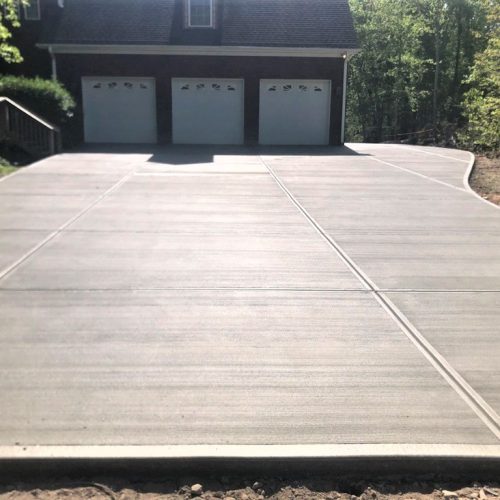Quality and Know-how: Legendary Concrete Brentwood Sets the Criterion
Quality and Know-how: Legendary Concrete Brentwood Sets the Criterion
Blog Article
The Eco-friendly Option: Concrete Sidewalks for Your Neighborhood
Concrete walkways are an ubiquitous function in most neighborhoods, yet their effect on the atmosphere is typically ignored. Selecting concrete for your community sidewalks can make a significant difference in terms of sustainability and eco-friendliness. The advantages of selecting concrete exceed mere aesthetic appeals and capability. By thinking about the ecological benefits and long-term effects on the area, the option of materials for sidewalks ends up being a crucial decision. Allow's check out why concrete sidewalks could be the environmentally friendly choice your neighborhood needs.
Advantages of Concrete Sidewalks
When thinking about the installment of sidewalks in a community, the advantages of selecting concrete over other products are considerable and numerous. Concrete sidewalks use durability, enduring hefty foot website traffic, weather condition variations, and ecological components better than alternative materials like asphalt or gravel.

Sturdiness and Longevity
Just how can concrete pathways outshine various other products in terms of resilience and longevity? Concrete pathways are renowned for their phenomenal durability and long life contrasted to different materials like asphalt or pavers. The intrinsic stamina of concrete makes it extremely immune to breaking, changing, and basic wear and tear brought on by foot web traffic, weather fluctuations, and other environmental variables. Unlike asphalt, which can soften in high temperatures and fracture in freezing conditions, concrete preserves its structural stability, needing very little maintenance over time.
Concrete sidewalks additionally have a longer lifespan than pavers, which are prone to uneven settling, weed development in between joints, and specific paver activity. The strong, continuous surface of concrete minimizes tripping dangers and ensures a smooth strolling course for pedestrians. Additionally, concrete's longevity minimizes the demand for frequent repair work or substitutes, making it a cost-efficient and sustainable selection for neighborhood walkways. By purchasing concrete pathways, neighborhoods can take pleasure in a reputable and resilient facilities that enhances the overall aesthetic charm and functionality of the area.
Low Upkeep Demands
Concrete sidewalks stand out for their marginal upkeep demands due to their long lasting nature and durable efficiency. Unlike alternative materials that might require regular repairs or replacements, concrete sidewalks use an economical service that requires little maintenance over time.
Regular upkeep for concrete walkways usually includes straightforward tasks such as routine cleaning to remove particles and periodic sealing to safeguard the surface area. In comparison to products like asphalt or pavers that might change, fracture, or deteriorate more quickly, concrete sidewalks preserve their architectural stability with very little intervention. In addition, any repair services that may be needed are usually localized and can be addressed swiftly, decreasing both the moment and expense connected with maintenance.

Environmental Advantages
With an emphasis on sustainability and eco-friendliness, concrete walkways provide significant ecological navigate here benefits that add to a greener area framework. Concrete is a product understood for its resilience and longevity, minimizing the requirement for regular substitutes. This long life lessens the ecological influence connected with the manufacturing and transportation of new materials for sidewalk construction. Furthermore, concrete pathways have a high solar reflectance index, indicating they reflect a considerable quantity of sunshine rather than absorbing and keeping warm. This high quality aids reduce the urban warm island impact, lowering power usage for cooling structures and improving general convenience in city areas.
In addition, concrete is a porous material that permits water to infiltrate into the ground, decreasing this stormwater runoff and helping in groundwater recharge. This helps avoid disintegration, lessen flooding, and keep the all-natural equilibrium of water supply in your area. By picking concrete sidewalks, communities can make a lasting selection that positively impacts the atmosphere and enhances the lifestyle for locals.
Enhancing Neighborhood Sustainability
By prioritizing sustainable facilities options, areas can grow an unified balance between environmental consciousness and community growth. Enhancing neighborhood sustainability entails a multifaceted strategy that goes past simply the environmental advantages of concrete sidewalks. Applying environment-friendly areas, promoting energy-efficient methods, and cultivating a feeling of neighborhood involvement are necessary components of creating a lasting area.
One way to improve area sustainability is via the assimilation of permeable concrete pathways. These sidewalks allow rain to permeate into the ground, decreasing stormwater runoff and minimizing the stress on community drain systems. Legendary Concrete Brentwood. By integrating permeable walkways, areas can improve water top quality, lower flooding dangers, and enhance general ecological strength
Moreover, promoting alternate transportation techniques such as walking and biking can substantially reduce carbon discharges and advertise a much Visit Your URL healthier way of living among homeowners. Developing risk-free pedestrian pathways, bike lanes, and designated greenways can encourage homeowners to count less on cars, further adding to the neighborhood's sustainability objectives.
Conclusion
To conclude, concrete sidewalks offer countless benefits for communities, including resilience, low upkeep demands, and environmental advantages. By picking concrete pathways, communities can enhance their sustainability and add to a much more eco-friendly setting. It is clear that concrete sidewalks are the excellent choice for areas looking to boost their infrastructure in a resilient and eco friendly fashion.
When thinking about the setup of sidewalks in an area, the benefits of choosing concrete over various other products are various and considerable. In addition, concrete's sturdiness minimizes the need for frequent repairs or substitutes, making it a sustainable and cost-effective choice for area pathways (Concrete Contractor).With an emphasis on sustainability and eco-friendliness, concrete pathways supply remarkable environmental advantages that add to a greener community infrastructure. Enhancing area sustainability entails a complex method that goes past just the environmental advantages of concrete sidewalks.In verdict, concrete sidewalks supply countless benefits for areas, consisting of resilience, low maintenance requirements, and ecological benefits
Report this page